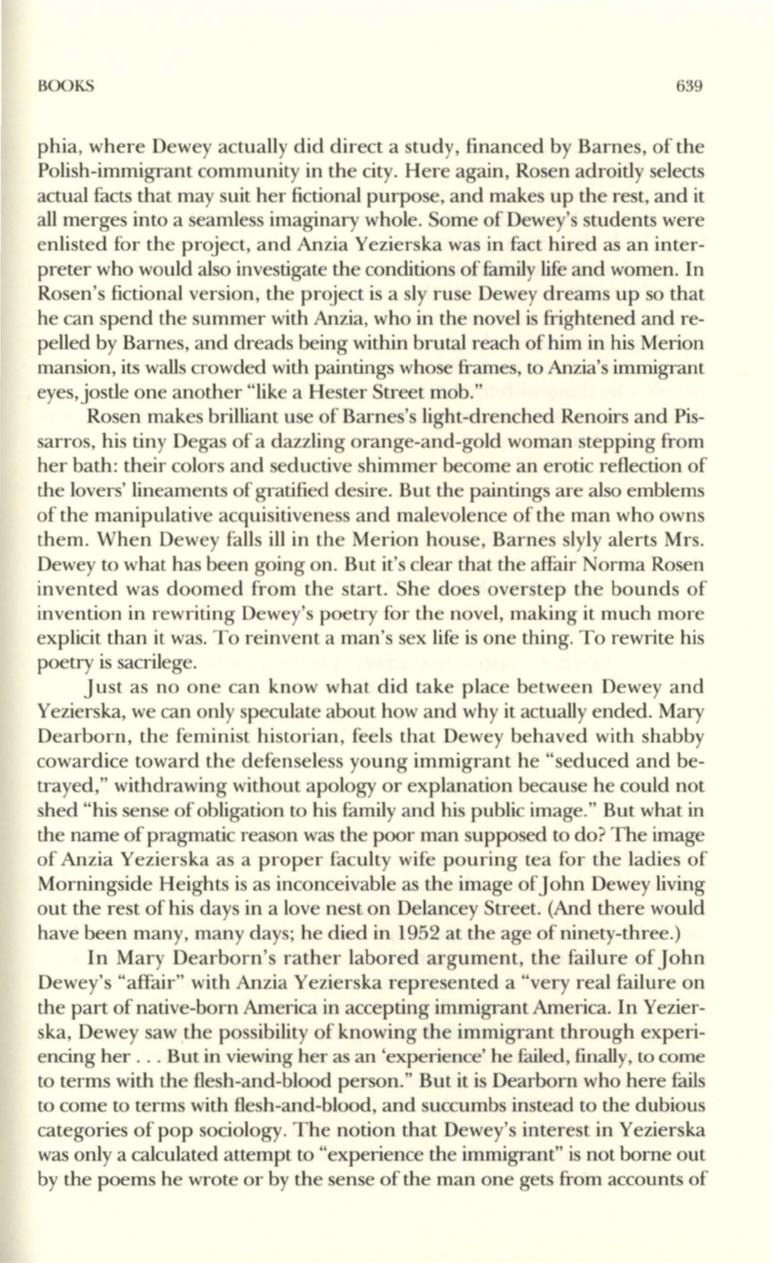
BOOKS
639
phia, where Dewey actually did direct a study, financed by Barnes, of the
Polish-immigrant community in the city. Here again, Rosen adroitly selects
actual facts that may suit her fictional purpose, and makes up the rest, and it
all merges into a seamless imaginary whole. Some of Dewey's students were
enlisted for the project, and Anzia Yezierska was in fact hired as an inter–
preter who would also investigate the conditions of family life and women. In
Rosen's fictional version, the project is a sly ruse Dewey dreams up so that
he can spend the summer with Anzia, who in the novel is frightened and re–
pelled by Barnes, and dreads being within brutal reach of him in his Merion
mansion, its walls crowded with paintings whose frames, to Anzia's immigrant
eyes, jostle one another "like a Hester Street mob."
Rosen makes brilliant use of Barnes's light-drenched Renoirs and Pis–
sarros, his tiny Degas of a dazzling orange-and-gold woman stepping from
her bath: their colors and seductive shimmer become an erotic reflection of
the lovers' lineaments of gratified desire. But the paintings are also emblems
of the manipulative acquisitiveness and malevolence of the man who owns
them. When Dewey falls ill in the Merion house, Barnes slyly alerts Mrs.
Dewey to what has been going on. But it's clear that the affair Norma Rosen
invented was doomed from the start. She does overstep the bounds of
invention in rewriting Dewey's poetry for the novel, making it much more
explicit than it was. To reinvent a man's sex life is one thing. To rewrite his
poetry is sacrilege.
Just as no one can know what did take place between Dewey and
Yezierska, we can only speculate about how and why it actually ended. Mary
Dearborn, the feminist historian, feels that Dewey behaved with shabby
cowardice toward the defenseless young immigrant he "seduced and be–
trayed," withdrawing without apology or explanation because he could not
shed "his sense of obligation to his family and his public image." But what in
the name of pragmatic reason was the poor man supposed to do? The image
of Anzia Yezierska as a proper faculty wife pouring tea for the ladies of
Morningside Heights is as inconceivable as the image ofJohn Dewey living
out the rest of his days in a love nest on Delancey Street. (And there would
have been many, many days; he died in 1952 at the age of ninety-three.)
In Mary Dearborn's rather labored argument, the failure of John
Dewey's "affair" with Anzia Yezierska represented a "very real failure on
the part of native-born America in accepting immigrant America. In Yezier–
ska, Dewey saw the possibility of knowing the immigrant through experi–
encing her ... But in viewing her as an 'experience' he failed, finally, to come
to terms with the flesh-and-blood person." But it is Dearborn who here fails
to come to terms with flesh-and-blood, and succumbs instead to the dubious
categories of pop sociology. The notion that Dewey'S interest in Yezierska
was only a calculated attempt to "experience the immigrant" is not borne out
by the poems he wrote or by the sense of the man one gets from accounts of


